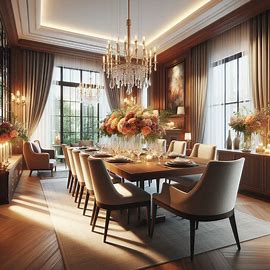
Introduction
Creating the perfect dining room is an exciting challenge that balances aesthetics, comfort, and practicality. Whether you’re furnishing a new home or upgrading an existing space, thoughtful design choices can transform your dining room into a welcoming hub for meals, conversations, and memories. This guide will walk you through key design elements, layout tips, decor ideas, and furniture selections to help you craft the dining room that fits your lifestyle and taste.
1. Understanding the Basics of Dining Room Design
1.1 Defining the Purpose and Style
Before diving into colors or furniture, consider how you want to use your dining room. Is it for formal dinners, casual family meals, or multipurpose entertaining? Your usage will influence your style choices, from elegant and classic to modern and casual.
For example, a formal dining room might feature a grand chandelier, rich wood furniture, and ornate details, while a casual space may emphasize comfort and practicality with cushioned chairs and easy-to-clean surfaces.
1.2 Determining the Right Size and Layout
Space planning is crucial. Measure your dining area and think about how many people you want to seat comfortably. Allow at least 24 inches of space per person at the table and ensure there is enough clearance around the table for chairs to pull out easily.
Common dining room layouts include:
-
Rectangular: Works well with long tables, maximizing seating capacity.
-
Square: Ideal for square tables, promoting an intimate setting.
-
Round: Great for small spaces and encouraging conversation.
2. Selecting the Ideal Dining Room Furniture
2.1 Choosing the Table
The dining table is the centerpiece of the room. Consider materials such as solid wood for durability, glass for a modern look, or metal for industrial styles. Round tables suit smaller spaces, while extendable tables offer flexibility for hosting larger groups.
| Table Shape | Pros | Cons |
|---|---|---|
| Rectangular | Seats many, versatile | Can feel formal or rigid |
| Round | Encourages conversation | Limited seating capacity |
| Square | Balanced, symmetrical | Can be space-consuming |
2.2 Picking the Right Chairs
Comfort is key. Look for chairs with good back support and padding if possible. Match the chair style to your table and overall decor — for instance, upholstered chairs for a formal room or simple wooden chairs for rustic charm.
2.3 Additional Furniture and Storage
Consider sideboards, buffets, or china cabinets to store dishes and display decor. These pieces not only add functionality but also contribute to the room’s aesthetic.
3. Choosing Colors, Lighting, and Flooring
3.1 Color Palette Ideas
Colors influence mood. Warm tones like reds, oranges, and yellows stimulate appetite and conversation, while cooler colors like blues and greens create a calm environment. Neutral shades offer flexibility and allow you to add pops of color with accessories.
3.2 Lighting Essentials
Layered lighting works best:
-
Ambient Lighting: Overhead fixtures like chandeliers or recessed lights provide general illumination.
-
Task Lighting: Pendant lights over the table help focus light where it’s needed.
-
Accent Lighting: Wall sconces or candles add ambiance and warmth.
Dimmers are highly recommended for controlling mood and brightness.
3.3 Flooring Choices
Durability and style matter. Hardwood floors bring warmth and elegance, tiles offer easy cleaning, and rugs can define the dining area while adding comfort.
4. Decorating Your Dining Room for Style and Personality
4.1 Wall Treatments
Consider paint, wallpaper, or textured panels. Artwork and mirrors can add visual interest and make the room feel larger.
4.2 Table Settings and Centerpieces
Your table décor sets the tone. Use seasonal centerpieces, elegant tableware, or simple greenery. Avoid clutter to keep the focus on the meal and company.
4.3 Incorporating Textiles
Curtains, cushions, and rugs add texture and soften the room’s look. Choose fabrics that complement your color scheme and are easy to maintain.
5. Practical Tips for Maintaining a Functional Dining Room
5.1 Keeping the Space Organized
Use storage furniture smartly to hide clutter. Regularly clean dining surfaces and upholstery to maintain freshness.
5.2 Flexibility and Multi-functionality
If space is limited, opt for furniture that serves multiple purposes, like extendable tables or storage benches.
5.3 Safety and Comfort Considerations
Ensure pathways are clear and furniture edges are safe, especially if you have children. Choose chairs and tables that provide ergonomic comfort.
Conclusion
Designing the perfect dining room is about balancing your lifestyle needs with your personal style. By carefully planning your layout, selecting the right furniture, and choosing complementary colors and lighting, you can create a space that is both beautiful and functional. Ready to transform your dining room into a welcoming haven for your family and friends? Share your ideas or questions below — I’d love to hear about your design journey!